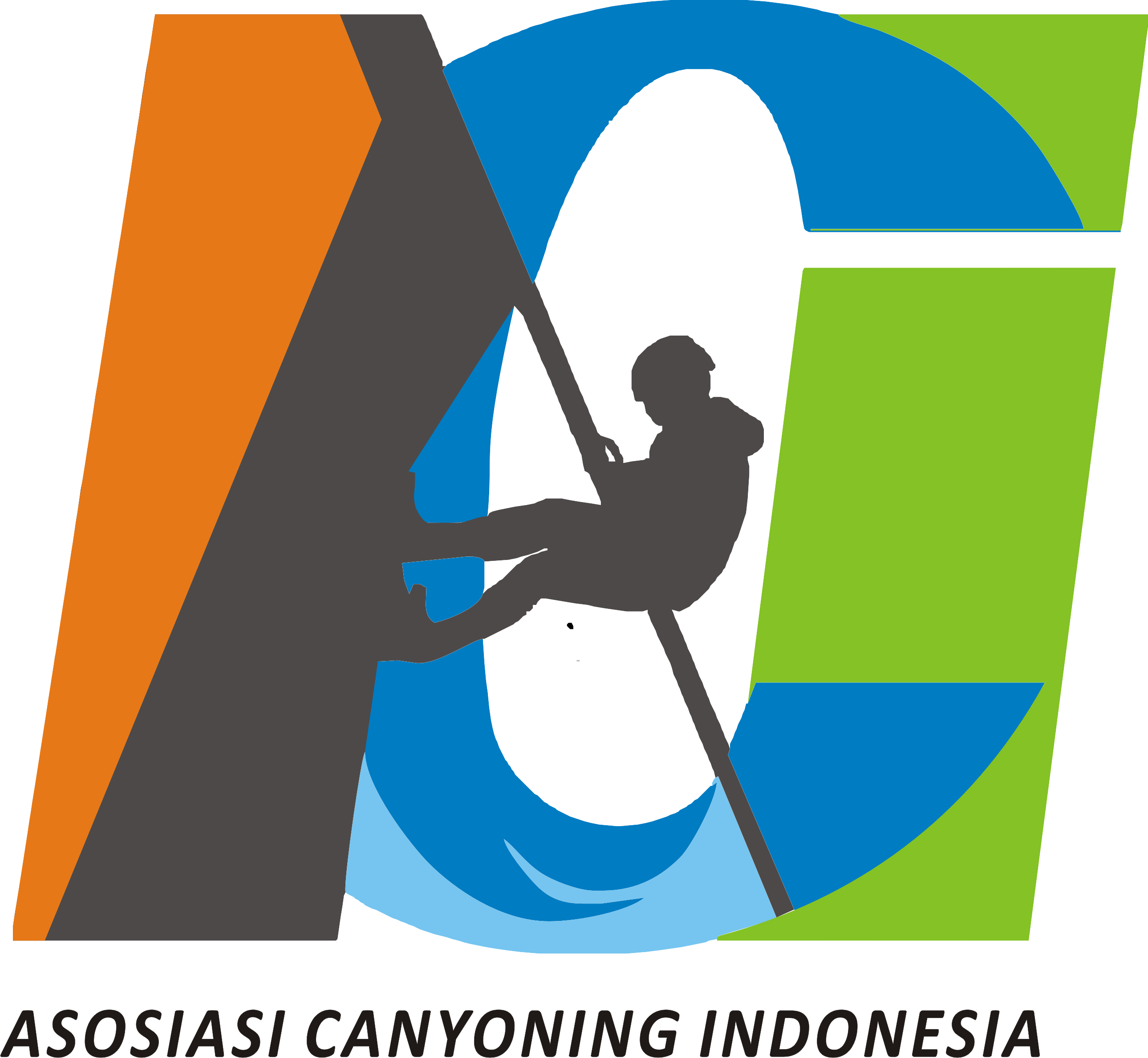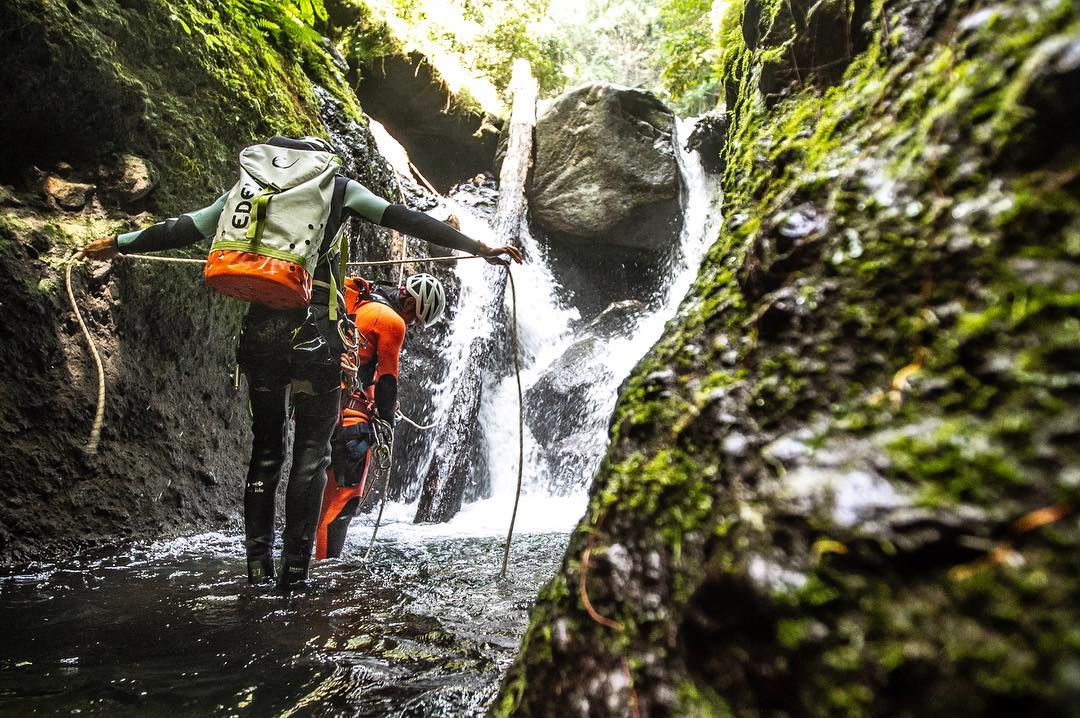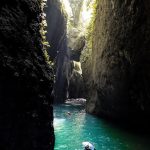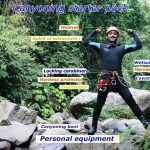Asosiasi Canyoning Indonesia mengikuti sistem penilaian internasional yang di buat oleh FFME (Federasi Canyoning Perancis) sebagai berikut:
FFME (International) rating system definition
The grading is based on a normal water flow during the regular canyoning season. This water level is relatively low, but not the lowest the water flow can get.
The grade is based on a group of 5 people who will descend the canyon for the first-time (on-sight), and whose technical ability is equivalent to the technical level of the canyon.
The descent should be done at a regular and reasonable pace, for the sake of safety and efficiency. (A personal record will not change the initial grading of the canyon.)
As a reminder, canyons are graded as follows:
The letter “V” followed by one Arabic numeral from 1 to 7 which corresponds to an increase in the difficulty of the vertical character.
The letter “A” followed by one Arabic numeral from 1 to 7 which corresponds to an increase in the difficulty of the aquatic character.
One Roman numeral for the commitment and exposure: from I to VI which corresponds to an increase in difficulty.
For example canyons rated v2.a3.III, or v5.a6.V, or v4.a5.III
| DIFFICULTY | v : Vertical character | a : Aquatic character |
| 1 Very easy | No compulsory vertical pitch. Absence of anchors and traverse lines, rope and harness are unnecessary for a normal, safe progression. No climbing / down-climbing | No water or walking in calm water. Swimming is optional. No jumps.No slides. |
| 2 Easy | Accessing the anchor and rappelling are easy, verticals less than or equal to 10m in height.Presence of traverse lines. Climbing/down-climbing is easy and a bit exposed. | Swim no longer than 10m in calm water. Easy jumps less than 3m in height. Short or gently sloping slide. |
| 3 A Little Difficult | Vertical pitches with a low water flow, and landing in a calm pool requiring swimming. Accessing the anchors and rappelling is simple, pitches are less than or equal to 30m in height, separated by flat areas large enough to let the team regroup.Traverse lines are easy to set-up and use.The technique for “walking” requires extra attention (specific foot placements) and analyzing the terrain which can be slippery, unstable, uneven, constricted, or in the water. Climbing / down-climbing (up to 3c French Climbing Grade), which are a bit exposed and may require using a rope. | Swims no further than 30m in calm water. Easy jumps from 3m to 5m. Long or moderately sloped slides. |
| 4 Somewhat Difficult | Vertical pitches with low to medium flows that can knock a rappeller off balance or stop them.Accessing the anchor is difficult and/or the pitch’s height is greater than 30m. Multi-pitch rappels with comfortable anchor locations.Rope will pass over abrasion points.Difficult to use traverse lines, portions of the pitch or the bottom of the pitch are not visible from the anchor, landing pools with water movements.Climbing / down-climbing up to 4c French Climbing Grade or A0 Aid Climbing Grade, exposed and/or necessary to use belaying techniques. | Prolonged immersion in water resulting in high energy loss. Large sieves/siphons less than 1m long and/or underwater. Simple jumps between 5m and 8m. Jumps less than 5m with difficult take-offs, trajectories, or landing. Big or steep sloped slides. |
| 5 Difficult | Vertical pitches with medium to high flow, difficult descent requiring trajectory management and/or balance.Multi-pitch rappels with hanging belays. Negotiation of hanging pools during descent.Slippery surface or the presence of an obstacle. Retrieving the rope is difficult (i.e.. while swimming, etc.)Exposed climbing / down-climbing, up to5c French Climbing Grade or A1 Aid Climbing Grade. | Prolonged immersion in cold water resulting in significant energy loss. Swimming in strong current that can affect a swimmer’s path, such as ferrying, recirculating current, and current direction changes. Whitewater movements such as hydraulics, eddies, trap pools, and undercuts that may trap a canyoner for a short period of time.Large sieves/siphons up to 2m long and/or underwater. Simple jumps between 8m and 10m. Jumps between 5m and 8m with difficult take-offs, trajectories, or landing. |
| 6 Very Difficult Exposed | Vertical pitches with strong to very strong water flow. Sustained waterfalls. Very difficult descent requiring trajectory management and/or balance.Rigging anchors is difficult: creating marginal natural anchors (rock pinch, etc.). Accessing the anchor is difficult (setting up a traverse line is very delicate, etc.)Exposed climbing / down-climbing, up to6a French Climbing Grade or A2 Aid Climbing Grade. Very slippery or unstable surfaces. Landing pools are emulsified with air bubbles. | Difficult swimming in strong currents which affect a swimmer’s path, such as ferrying, recirculating current, and current direction changes. Obvious whitewater movements such as hydraulics, eddies, trap pools, and undercuts that will trap a canyoner for a period of time. Technical siphons/sieves up to 1m with current or eventual current. Large sieves/siphons up to 3m long and/or underwater. |
| 7 Extremely Difficult Very Exposed | Vertical pitches with very strong to extremely strong water flow. Very sustained waterfalls. Extremely difficult descent requiring special management of the rope, of trajectory, of balance, and rhythm. Exposed climbing / down-climbing, above6a French Climbing Grade or A2 Aid Climbing Grade. Limited visibility and frequent obstacles. Rappels finish in powerful water movements or pools. Control over breathing: sections requiring apnea. | Extremely difficult swimming in very strong current which affect a swimmer’s path, such as ferrying, recirculating current, and current direction changes. Whitewater movements such as hydraulics, eddies, trap pools, and undercuts that will trap a canyoner for a long period of time. Technical siphons/sieves greater than 1m with current or eventual current or without visibility. Large sieves/siphons greater than 3m long and/or underwater. |
Commitment / Duration Table
Attention: The times referenced below should be adjusted according to the group profile.
| Commitment / Duration | Criteria |
| I | Able to get away from a flood easily and quickly. Easy escapes all along the canyon. Total time (approach, descent, return) less than 2 hours. |
| II | Able to get away from a flood within 15 minutes of progression. Escapes are possible within 30 minutes of progression. Total time (approach, descent, return) within 2 to 4 hours. |
| III | Able to get away from a flood within 30 minutes of progression. Escapes are possible within 1 hour of progression. Total time (approach, descent, return) within 4 to 8 hours. |
| IV | Able to get away from a flood within 1 hour of progression. Escapes are possible within 2 hours of progression. Total time (approach, descent, return) within 8 hours to 1 day. |
| V | Able to get away from a flood within 2 hours of progression. Escapes are possible within 4 hours of progression. Total time (approach, descent, return) within 1 to 2 days. |
| VI | The possibility to get away from a flood requires more than 2 hours of progression. Escapes are possible after 4 hours of progression. Total time (approach, descent, return) greater than 2 days. |



